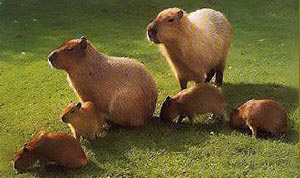Difference between revisions of "Teica"
m (categories and content) |
m (images) |
||
| Line 1: | Line 1: | ||
==Overview== | ==Overview== | ||
A mammal standing about .5 meters at the shoulder, and having a body length nearing 1 meter. Tika are used as a primary livestock, and its wooly hair for use in the manufacture of clothing. The tika resembles a Terran “Guinea Pig” in all but size. Wild tika will still have the goring tusks used for uprooting edible roots, and other food. These tusks are pulled in young domestics to prevent injury to handlers. | [[File:teica.png|thumb|300x|right|Teica]]A mammal standing about .5 meters at the shoulder, and having a body length nearing 1 meter. Tika are used as a primary livestock, and its wooly hair for use in the manufacture of clothing. The tika resembles a Terran “Guinea Pig” in all but size. Wild tika will still have the goring tusks used for uprooting edible roots, and other food. These tusks are pulled in young domestics to prevent injury to handlers. | ||
;Common Names: <list names the species is referenced by--> | ;Common Names: <list names the species is referenced by--> | ||
| Line 45: | Line 45: | ||
==See Also== | ==See Also== | ||
<--links to related material--> | <--links to related material--> | ||
[[Category:Fauna]] | [[Category:Fauna]] | ||
[[Category:Mammal]] | [[Category:Mammal]] | ||
Revision as of 04:58, 17 January 2019
Overview
A mammal standing about .5 meters at the shoulder, and having a body length nearing 1 meter. Tika are used as a primary livestock, and its wooly hair for use in the manufacture of clothing. The tika resembles a Terran “Guinea Pig” in all but size. Wild tika will still have the goring tusks used for uprooting edible roots, and other food. These tusks are pulled in young domestics to prevent injury to handlers.
- Common Names
- <list names the species is referenced by-->
Description
- Classification
- mammal
- Size
- <--number--> kg (<--number--> pounds), <--height--> m ( <--height--> feet/inches), <length--> as appropriate
- Appearance
- <--general description, include body part ratios as required, consider: skeleton, mobility, body covering, respiratory system, nervous System, additional features-->
- Sexual dimorphism
- <--note differences between the sexes-->
- Variance
- <--any other variance, include subspeciation-->
Ecology
- Habitat
- <--primary and secondary climate and terrain-->
- Diet
- <--what do they eat-->
Behaviour
- Social grouping
- <--herds, pack, solitary, etc-->
- Temperament
- <--skittishness, aggression-->
- Intelligence
- <--apparent intelligence-->
- Reproduction
- <--method, cycles, associated behaviours-->
Sub-Species
Common Teica
Domesticated variety raised primarily as food stock. They tend to the brown haired, black legged and faced colours typical of the species.
Desert Teica
Light brown with sandy tones on the legs and belly. A leaner bodied species well adapted to arid climates.
Marsh Teica
Dark brown nearly black all over, this wild species is common in marshlands and boggier swamps. They have webbed toes making them passable swimmers.
Red Teica
Red-brown in colour, with a lighter belly and neck. This species tends to hilly and flat lands of a temperature clime.
Woods Teica
Brown with black face and legs, and a white or cream coloured neck and belly.
Wooly Teica
Very coarse wooly coat of grey brown colour, with dark legs and face typical of their shorter haired cousins. This species is domesticated as a textile producer. Their hair is sheared, combed and collected for the production of woollen goods.
Domestication
- General
- <--brief note about domestication-->
- Resources
- <--resources obtained from domestication-->
See Also
<--links to related material-->
